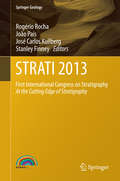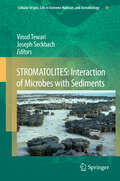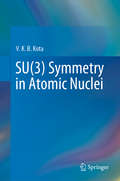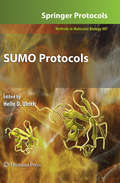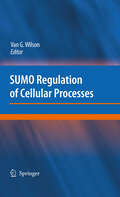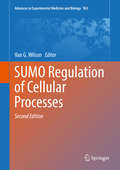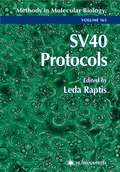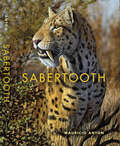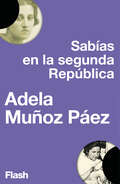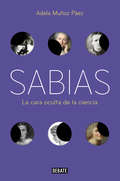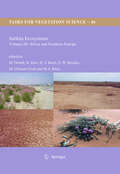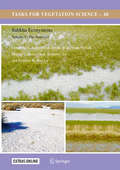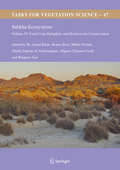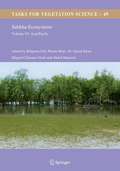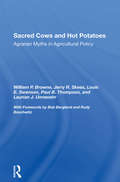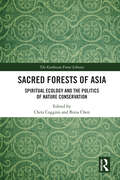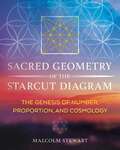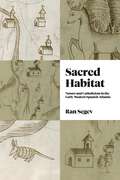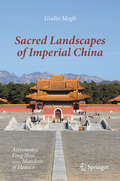- Table View
- List View
STEMscopes™ Texas: Science Literacy, [Grade] 3, English
by Inc. Accelerate Learning Rice UniversityNIMAC-sourced textbook
STEMscopes™ Texas: Science Literacy, [Grade] 4, English
by Inc. Accelerate Learning Rice UniversityNIMAC-sourced textbook
STM Investigation of Molecular Architectures of Porphyrinoids on a Ag(111) Surface
by Florian BuchnerThe self-assembly of large organic molecules has become a vividly explored and interdisciplinary field in science. One major goal is the tailored fabrication of highly ordered, molecular networks, which are stabilized on a metal surface. Metalloporphyrins receive particular attention, because their distinct intrinsic functionalities make them promising candidates for applications in chemical sensors, solar cells, and for tailored catalytic processes. Based on scanning tunneling microscopy investigations, several novel and fundamental contributions are presented, which has led to a new level of understanding. Highlights are the results with respect to intramolecular conformation and supramolecular ordering, electronic interactions with the substrate, surface confined synthesis such as in-situ metallation reactions, and ligand effects.The number of publications this work has led to emphasises its quality and significance.
STRATI 2013: First International Congress on Stratigraphy At the Cutting Edge of Stratigraphy (Springer Geology)
by João Pais Rogério Rocha José Carlos Kullberg Stanley FinneyThe 1st International Congress on Stratigraphy (STRATI 2013), hold in Lisbon, 1–7 July 2013, follows the decision to internationalize the conferences previously organized by the French Committee of Stratigraphy (STRATI), the last one of which was held in Paris in 2010. Thus, the congress possesses both the momentum gained from an established conference event and the excitement of being the first International Congress on Stratigraphy. It is held under the auspices of the International Commission on Stratigraphy (IUGS) and it is envisaged that this first congress will lead to others being held in the future.This book includes all papers accepted for oral or poster presentation at the 1st International Congress on Stratigraphy. Papers include a short abstract, main text, figures, tables and references. Each paper has been reviewed by two internationally renowned scientists.
STROMATOLITES: Interaction of Microbes with Sediments
by Joseph Seckbach Vinod TewariSTROMATOLITES: Interaction of Microbes with Sediments provides an overview and latest information about the formation of Stromatolites as a result of interaction of microbes with sediments. Eighty-three expert scientists from twenty-seven countries present the chapters in this volume which have been reviewed by thirty four referees. The volume deals with ancient to modern examples of stromatolites and microorganisms which are observed in various diverse environments, such as: marine, nonmarine, lacustrine and extreme geographical areas covering almost the whole earth. The reviews are original articles written by leading experienced experts, some chapters deal with latest instrumental techniques used for the study of microbes and Stromatolites. Other chapters have been contributed by young researchers who revealed updated data on Stromatolites. The astrobiological implications of early microbiota, sulfur isotopic ratios, microbialites in extreme conditions on earth has opened up new vistas in the search of extraterrestrial life.
SU(3) Symmetry in Atomic Nuclei
by V. K. KotaThis book provides an understandable review of SU(3) representations, SU(3) Wigner–Racah algebra and the SU(3) ⊃ SO(3) integrity basis operators, which are often considered to be difficult and are avoided by most nuclear physicists. Explaining group algebras that apply to specific physical systems and discussing their physical applications, the book is a useful resource for researchers in nuclear physics. At the same time it helps experimentalists to interpret data on rotational nuclei by using SU(3) symmetry that appears in a variety of nuclear models, such as the shell model, pseudo-SU(3) model, proxy-SU(3) model, symplectic Sp(6, R) model, various interacting boson models, various interacting boson–fermion models, and cluster models. In addition to presenting the results from all these models, the book also describes a variety of statistical results that follow from the SU(3) symmetry.
SUMO Protocols
by Helle UlrichWhile the small ubiquitin-related modifier SUMO uses a conjugation and de-conjugation system closely related to that of ubiquitin itself, its functions are highly diverse and largely independent of the ubiquitin system. In SUMO Protocols, leading experts present a collection of methods intended to highlight important features unique to the biology of SUMO in order to support future SUMO research. The first half of the volume focuses on the identification and functional characterization of SUMO targets and interactors, while the second half covers essential biochemical methods for the manipulation of the enzymatic components of the SUMO system. Written in the highly successful Methods in Molecular BiologyTM series format, the chapters include brief introductions to the subject, lists of the necessary materials and reagents, step-by-step, readily reproducible laboratory protocols, and the Notes sections, which provide tips on troubleshooting and avoiding known pitfalls. Unique and cutting-edge, SUMO Protocols provides the necessary tools for biochemists, molecular and cellular biologists as well as research-oriented clinicians not yet familiar with this vital system.
SUMO Regulation of Cellular Processes
by G. WilsonOver a decade ago, a small cellular protein of 12 kDa, with 18% homology to the well-known ubiquitin protein, was co-discovered and termed Small Ubiquitin-like Modifier, or SUMO. Sumoylation is a post-translational modification that utilizes SUMO as the modifier group covalently attached to target substrates. This state-of-the art review on the sumoylation system deals with protein modification as it pertains to regulation of diverse cellular functions. Each chapter has been written by a leading researcher and covers the role of sumoylation in fundamental biochemical activities (transcription, RNA processing, chromatin remodelling, DNA repair, nucleocytoplasmic transport, ion channel regulation, and metabolic pathways). The text also examines the part sumoylation plays in critical cellular processes such as mitosis, meiosis, differentiation, senescence, and apoptosis. Lastly, the emerging role of sumoylation in specific diseases, including cancer and diabetes as well as neurodegenerative ones, is explored with an emphasis on defining molecular mechanisms that may provide new targets for treatment or prevention. While SUMO was discovered more than 10 years ago, this is still a relatively young field, and much remains to be discovered about the biochemical and biological properties of this modification system. In just the last few years, it has become clear that sumoylation modifies hundreds of cellular proteins, and there has been increased appreciation for the breadth of cellular functions that are impacted by this post-translational modification.
SUMO Regulation of Cellular Processes
by Van G. WilsonOver a decade ago, a small cellular protein of 12 kDa, with 18% homology to the well-known ubiquitin protein, was co-discovered and termed Small Ubiquitin-like Modifier, or SUMO. Sumoylation is a post-translational modification that utilizes SUMO as the modifier group covalently attached to target substrates. This state-of-the art review on the sumoylation system deals with protein modification as it pertains to regulation of diverse cellular functions. Each chapter has been written by a leading researcher and covers the role of sumoylation in fundamental biochemical activities (transcription, RNA processing, chromatin remodelling, DNA repair, nucleocytoplasmic transport, ion channel regulation, and metabolic pathways). The text also examines the part sumoylation plays in critical cellular processes such as mitosis, meiosis, differentiation, senescence, and apoptosis. Lastly, the emerging role of sumoylation in specific diseases, including cancer and diabetes as well as neurodegenerative ones, is explored with an emphasis on defining molecular mechanisms that may provide new targets for treatment or prevention. While SUMO was discovered more than 10 years ago, this is still a relatively young field, and much remains to be discovered about the biochemical and biological properties of this modification system. In just the last few years, it has become clear that sumoylation modifies hundreds of cellular proteins, and there has been increased appreciation for the breadth of cellular functions that are impacted by this post-translational modification.
SUMO Regulation of Cellular Processes
by Van G. WilsonOver a decade ago, a small cellular protein of 12 kDa, with 18% homology to the well-known ubiquitin protein, was co-discovered and termed Small Ubiquitin-like Modifier, or SUMO. Sumoylation is a post-translational modification that utilizes SUMO as the modifier group covalently attached to target substrates. This state-of-the art review on the sumoylation system deals with protein modification as it pertains to regulation of diverse cellular functions. Each chapter has been written by a leading researcher and covers the role of sumoylation in fundamental biochemical activities (transcription, RNA processing, chromatin remodelling, DNA repair, nucleocytoplasmic transport, ion channel regulation, and metabolic pathways). The text also examines the part sumoylation plays in critical cellular processes such as mitosis, meiosis, differentiation, senescence, and apoptosis. Lastly, the emerging role of sumoylation in specific diseases, including cancer and diabetes as well as neurodegenerative ones, is explored with an emphasis on defining molecular mechanisms that may provide new targets for treatment or prevention. While SUMO was discovered more than 10 years ago, this is still a relatively young field, and much remains to be discovered about the biochemical and biological properties of this modification system. In just the last few years, it has become clear that sumoylation modifies hundreds of cellular proteins, and there has been increased appreciation for the breadth of cellular functions that are impacted by this post-translational modification.
SV40 Protocols
by Leda RaptisA panel of highly experienced investigators describe in step-by-step fashion key techniques for experimentally detecting SV40 in human tumors, for exploiting its use in human gene therapy, and for studying its replication and its mechanisms of neoplastic transformation. Included are methods for growing SV40 and related viruses in tissue culture, for in vivo and in vitro replication and transcription of SV40 DNA, for the use of retroviral vectors to express SV40 tumor antigens in cultured cells, and the use of transgenic mouse models based on the SV40 large T antigen. Detailed and highly practical, SV40 Protocols offers both clinical and basic researchers powerful, well-tested tools for research on SV40 replication and neoplastic transformation, as well as techniques for its detection in human tumors and for creating and using powerful new gene therapy vectors.
SWORDS INTO MARKET SHARES: Technology, Economics, and Security in the New Russia
by Glenn E. SchweitzerWhile researching this book, Glenn Schweitzer met four Moscow physicists who were trying to license Russian technology to western firms for product manufacture. During the worst times, they were reduced to driving taxis to keep things afloat. He asked them, will technological innovation have a discernible impact on the Russian economy in the coming decade? No, was the immediate reply. Are they right?In Swords into Market Shares, Schweitzer examines the roots of such pessimism and the prospects for Russia to prosper from its technology in the post-Soviet world. He explores the different visions of prosperity held by entrepreneurs, technologists, and government officials and goes on to examine the barriers to progress as Russia struggles to build a viable technology industry on its own terms. In accessible language, this book talks about technology's place within Russia's economy and its research and development infrastructure. Schweitzer looks at the impact of the Soviet legacy--central planning, lack of priorities, scant incentives for personal initiative--and the aftermath of the Russian financial meltdown of 1998.He also reviews the experiences of American companies that have invested in Russian technology and examines the results of pressure to reform according to the economic model of the West. Schweitzer goes on to document the problems of economic crime and government corruption, which plague activities designed to generate income in Russia. He discusses the lack of protection for intellectual property and taxation issues that stand in the way of technological innovation. The book looks at the impact of the "brain drain" as Russian experts seek greener pastures--not only the ominous recruitment of Russian biological weapons experts and the acquisition of military technology by "rogue" nations--but also Russia's own program to sell military technology for badly needed funds.Schweitzer's use of case studies and examples puts a human face on these issues. He also discusses Russia's 60 "science cities"--sites of state research centers--with close-ups of three "nuclear cities."Can the technical strengths of the Soviet military complex find a place in civilian Russia? How can this vast country sustain even a minimal standard of living? Swords into Market Shares addresses these and other key questions and explores fundamental policy issues confronting both Russia and the United States as Russia struggles for an economic foothold.
SYSTEMATICS AND THE ORIGIN OF SPECIES: On Ernst Mayr's 100th Anniversary
by National Academy of Sciences of the National AcademiesIn December 2004, the National Academy of Sciences sponsored a colloquium on “Systematics and the Origin of Species” to celebrate Ernst Mayr’s 100th anniversary and to explore current knowledge concerning the origin of species. In 1942, Ernst Mayr, one of the twentieth century’s greatest scientists, published Systematics and the Origin of Species, a seminal book of the modern theory of evolution, where he advanced the significance of population variation in the understanding of evolutionary process and the origin of new species. Mayr formulated the transition from Linnaeus’s static species concept to the dynamic species concept of the modern theory of evolution and emphasized the species as a community of populations, the role of reproductive isolation, and the ecological interactions between species. In addition to a preceding essay by Edward O. Wilson, this book includes the 16 papers presented by distinguished evolutionists at the colloquium. The papers are organized into sections covering the origins of species barriers, the processes of species divergence, the nature of species, the meaning of “species,” and genomic approaches for understanding diversity and speciation.
Sabertooth (Life of the Past)
by Mauricio Antón“A unique review of the many unusual and nearly worldwide occurrences of sabertooths and their relatives over more than 50 million years.” —ChoiceWith their spectacularly enlarged canines, sabertooth cats are among the most popular of prehistoric animals, yet it is surprising how little information about them is available for the curious layperson. What’s more, there were other sabertooths that were not cats, animals with exotic names like nimravids, barbourofelids, and thylacosmilids. Some were no taller than a domestic cat, others were larger than a lion, and some were as weird as their names suggest. Sabertooths continue to pose questions even for specialists. What did they look like? How did they use their spectacular canine teeth? And why did they finally go extinct? In this visual and intellectual treat of a book, Mauricio Antón tells their story in words and pictures, all scrupulously based on the latest scientific research. The book is a glorious wedding of science and art that celebrates the remarkable diversity of the life of the not-so-distant past.“The best paleomammal artist working today [and] his knowledge of sabertooths and their evolution is second to none.” —Lars Werdelin, Swedish Museum of Natural History“Mauricio Antón is one of the best paleoartists. What sets him apart is the fact that he is a great paleontologist in his own right. Probably no one else has thought more about sabertooth than he has. As a result, his illustrations often demonstrate a particular behavior of the extinct mammal that he has personally researched or display a unique point of view.” —Xiaoming Wang, Natural History Museum of Los Angeles
Sabias en la Segunda República (Flash Ensayo)
by Adela Muñoz PáezUn breve recorrido por la historia de la ciencia española y sus primeras grandes científicas. ¿Qué papel desempeñaron las mujeres durante la Edad de Plata que la ciencia vivió en la Segunda República española? Adela Muñoz Páez rescata la historia de algunas de las mujeres españolas que han hecho contribuciones relevantes a la ciencia y paralelamente, para entender por qué fueron tan escasas y hoy son tan desconocidas, realiza un paseo por la España de comienzos del siglo XX hasta nuestros días. Así, descubriremos que el movimiento feminista español gestado a finales del siglo XIX dio sus frutos más brillantes durante la Segunda República; que debido a la guerra una generación entera de científicas cayó en el olvido y que durante el franquismo no solo se anularon todos los logros conseguidos en cuestiones de igualdad, sino que se desprestigió a las mujeres y los hombres que los protagonizaron y se borraron sus huellas de los anales de la ciencia. Hoy su redescubrimiento es un ejercicio de justicia histórica para que por fin brillen con todo su esplendor.
Sabias: La otra cara de la ciencia
by Adela Muñoz PáezUn fascinante recorrido por la historia de las mujeres de la ciencia. ¿Quién fue Enheduanna? ¿Y Émilie de Châtelet? ¿Por qué los maestros cerveceros consideran su mentora a Hildegarda de Bingen, una monja del siglo XI? ¿Fue Marie Curie merecedora de los dos premios Nobel de ciencias que recibió? ¿Habría sido posible descifrar la estructura del ADN sin el trabajo de Rosalind Franklin? ¿Por qué es tan desconocida la mujer que desentrañó la estructura de la penicilina? ¿Qué papel tuvieron las mujeres durante la Edad de Plata que la ciencia vivió en la Segunda República española? En este libro rescatamos la historia de algunas de las mujeres que han hecho contribuciones relevantes en la ciencia y paralelamente, para entender porqué fueron tan escasas y hoy son tan desconocidas, realizamos un recorrido por la historia. En este paseo descubrimos que hasta bien entrado el siglo XX, las mujerestuvieron vetado el ingreso en las universidades y el ejercicio de muchas profesiones que requerían estudios, y que antes habían sido expulsadas de las bibliotecas de los monasterios, los centros donde se refugió el saber durante la Edad Media. También descubrimos que sus historias fueron borradas de los anales de la ciencia o sus contribuciones les fueron arrebatadas. Las mujeres científicas de la historia están siendo hoy redescubiertas para pasmo y solaz de propios y extraños, y brillan con todo su esplendor.
Sabkha Ecosystems
by Münir Öztürk Benno Böer Hans-Jörg Barth Siegmar-W. Breckle M. Ajmal Khan Miguel Clüsener-GodtThis book is part of the Sabkha Ecosystems series. The series is designed to provide information on sabkha ecosystems of different regions. It will add to the collective knowledge available about saline ecosystems and also focuses on the African region where only limited information is currently available on.
Sabkha Ecosystems Volume V: The Americas
by Siegmar-W. Breckle Miguel Clüsener-Godt M. Ajmal Ajmal Khan Benno Boër Münir Ȫzturk Bilquees GulThis book is a part of the Sabkha Ecosystems series which was designed to provide information on sabkha ecosystems of different regions and to add to the collective knowledge available about saline ecosystems. The comprehensive coverage assists the reader gaining a thorough understanding of sabkha geology, hydrology, geomorphology, zoology, botany, ecology and ecosystem functioning, as well as sabkha conservation, utilization and development. Volume I focused on The Arabian Peninsula and Adjacent Countries, volume II was based on describing saline ecosystems of West and Central Asia , volume III referred to Africa and Southern Europe, while volume IV focused on Cash Crop Halophyte and Biodiversity Conservation. The present volume V focuses on Americans.
Sabkha Ecosystems: Cash Crop Halophyte and Biodiversity Conservation
by Münir Öztürk Benno Böer M. Ajmal Khan Miguel Clüsener-Godt Bilquees Gul Thabit Zahran AbdessalaamSustainable development is the key for the survival in 21st century. The natural resources are finite and cannot be used with impunity because we are the custodian of these resources and have responsibility to pass these to the next generation. This monumental task requires several major commitments and most important of them is to arrest population explosion which has already reached seven billion. Natural resources like air to breath, food to eat, and water to drink, and fossil fuel to maintain this life style are being overexploited. Unrestrained consuming culture will accelerate undesired situation. This situation will have more dire consequences in resource limited ecosystems like dry lands. Given the severe scarcity of water, ever increasing population and soil salinization out of the box solutions for the provision of food and clean energy is required to spare meager fresh water resources for conventional agriculture. This volume contains a number of articles dealing with halophyte ecology, bio-geography, ecophysiology, hyper-saline soils, biofuels, biosaline agriculture, biosaline landscaping, climate change mitigation, and biodiversity. It also contains the communication of innovative ideas, such as the research into floating mangroves, seagrass terraces, as well as a World Halophyte Garden containing all known salt-tolerant plant species. It is hoped that the information provided will not only advance vegetation science, but that it will truly generate more interdisciplinarity, networking, awareness, and inspire farmers, and agricultural and landscaping stakeholders to seriously engage in halophyte cash crop production in coastal hyper-saline areas.
Sabkha Ecosystems: Volume VI: Asia/Pacific (Tasks for Vegetation Science #49)
by Benno Böer M. Ajmal Khan Miguel Clüsener-Godt Bilquees Gul Abdul HameedThis book is the sixth and final volume in the Tasks for Vegetation Science book series, and it concludes the most comprehensive scientific documentation dealing with hypersaline ecosystems of the world.
Sacred Cows And Hot Potatoes: Agrarian Myths And Agricultural Policy
by Paul Thompson William P. Browne Jerry R Skees Louis E SwansonSacred Cows and Hot Potatoes challenges many of the assumptions of current agricultural policies—such as equating "farm" with "rural," high farm prices with high farm incomes, or farm programs with food programs—and examines the agrarian roots of these policies. From the origins of agrarian myths to the latest controversies over farming and the environment, this book provides an overview of the use and abuse of agrarian values in policymaking. Illustrated with pictures, cartoons, and graphs, the book will appeal to a broad audience, including policymakers, rural sociologists, agricultural economists, political scientists, ethicists, and the interested public.
Sacred Forests of Asia: Spiritual Ecology and the Politics of Nature Conservation (The Earthscan Forest Library)
by Chris Coggins Bixia ChenPresenting a thorough examination of the sacred forests of Asia, this volume engages with dynamic new scholarly dialogues on the nature of sacred space, place, landscape, and ecology in the context of the sharply contested ideas of the Anthropocene. Given the vast geographic range of sacred groves in Asia, this volume discusses the diversity of associated cosmologies, ecologies, traditional local resource management practices, and environmental governance systems developed during the pre-colonial, colonial, and post-colonial periods. Adopting theoretical perspectives from political ecology, the book views ecology and polity as constitutive elements interacting within local, regional, and global networks. Readers will find the very first systematic comparative analysis of sacred forests that include the karchall mabhuy of the Katu people of Central Vietnam, the leuweng kolot of the Baduy people of West Java, the fengshui forests of southern China, the groves to the goddess Sarna Mata worshiped by the Oraon people of Jharkhand India, the mauelsoop and bibosoop of Korea, and many more. Comprising in-depth, field-based case studies, each chapter shows how the forest’s sacrality must not be conceptually delinked from its roles in common property regimes, resource security, spiritual matters of ultimate concern, and cultural identity. This volume will be of great interest to students and scholars of indigenous studies, environmental anthropology, political ecology, geography, religion and heritage, nature conservation, environmental protection, and Asian studies.
Sacred Geometry of the Starcut Diagram: The Genesis of Number, Proportion, and Cosmology
by Malcolm Stewart• Lavishly illustrated with hundreds of detailed diagrams and technical illustrations exploring the evolution and importance of the starcut diagram • Shows how the starcut diagram underlies the shaman&’s dance in China, the Vedic Fire Altar in India, Raphael frescoes, labyrinth designs, the Great Pyramid in Egypt, and the building of ancient cities • Explains how the starcut diagram was used in building and design, how it relates to Pythagoras&’s Tetrakys, and how it contains knowledge of the Tree of Life As Malcolm Stewart reveals in this lavishly illustrated study, the simplesquare figure of the Starcut diagram, created only with circles, has extraordinary geometric properties. It allows you to make mathematically exact measurements and build perfectly true level structures without a computer, calculator, slide rule, plumb bob, or laser level. Sharing his extensive research, along with hundreds of detailed diagrams and technical illustrations, the author shows how the Starcut diagram was the key to the building of humanity&’s first cities and how it underlies many significant patterns and proportions around the world. Using circles drawn from the vesica piscis, Stewart explains how to create the Starcut diagram and shows how this shape was at the foundation of ancient building and design, illustrating the numerous connections between the diagram and the creation of mandalas and yantras, stained glass windows, architectural ground plans, temples and other sacred buildings, and surveying methods. He also shows how the Starcut diagram reveals ancient geometric knowledge of pi, the Fibonacci sequence, Pythagorean shapes and seals, the golden ratio, the power of 108 and other sacred numbers, and magic squares. Exploring the Starcut diagram&’s cosmological and theological implications, Stewart explains how it contains knowledge of the Tree of Life and the Kabbalah. He examines how it relates to the Tetraktys, the key teaching device of Pythagoras, and other cosmograms. Demonstrating the ancient relationships existing between number, geometry, cosmology, and musical harmony, the author shows how the simple shape of the Starcut diagram unifies the many threads of sacred geometry into one beautiful mathematical tapestry.
Sacred Habitat: Nature and Catholicism in the Early Modern Spanish Atlantic (Iberian Encounter and Exchange, 475–1755)
by Ran SegevKnown as a time of revolutions in science, the early modern era in Europe was characterized by the emergence of new disciplines and ways of thinking. Taking this conceit a step further, Sacred Habitat shows how Spanish friars and missionaries used new scholarly approaches, methods, and empirical data from their studies of ecology to promote Catholic goals and incorporate American nature into centuries-old church traditions.Ran Segev examines the interrelated connections between Catholicism and geography, cosmography, and natural history—fields of study that gained particular prominence during the sixteenth and seventeenth centuries—and shows how these new bodies of knowledge provided innovative ways of conceptualizing and transmitting religious ideologies in the post-Reformation era. Weaving together historical narratives on Spain and its colonies with scholarship on the Catholic Reformation, Atlantic science, and environmental history, Segev contends that knowledge about American nature allowed pious Catholics to reconnect with their religious traditions and enabled them to apply their beliefs to a foreign land.Sacred Habitat presents a fresh perspective on Catholic renewal. Scholars of religion and historians of Spain, colonial Latin America, and early modern science will welcome this provocative intervention in the history of empire, science, knowledge, and early modern Catholicism.
Sacred Landscapes of Imperial China: Astronomy, Feng Shui, and the Mandate of Heaven
by Giulio MagliThis book analyses the magnificent imperial necropolises of ancient China from the perspective of Archaeoastronomy, a science which takes into account the landscape in which ancient monuments are placed, focusing especially but not exclusively on the celestial aspects. The power of the Chinese emperors was based on the so-called Mandate of Heaven: the rulers were believed to act as intermediaries between the sky gods and the Earth, and consequently, the architecture of their tombs, starting from the world-famous mausoleum of the first emperor, was closely linked to the celestial cycles and to the cosmos. This relationship, however, also had to take into account various other factors and doctrines, first the Zhao-Mu doctrine in the Han period and later the various forms of Feng Shui. As a result, over the centuries, diverse sacred landscapes were constructed. Among the sites analysed in the book are the “pyramids” of Xi’an from the Han dynasty, the mountain tombs of the Tang dynasty, and the Ming and Qing imperial tombs. The book explains how considerations such as astronomical orientation and topographical orientation according to the principles of Feng Shui played a fundamental role at these sites.


